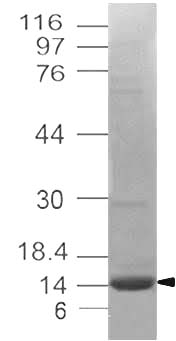Recombinant Human Stathmin/STMN1 (C-6His)
Shipping Info:
For estimated delivery dates, please contact us at [email protected]
| Amount : | 50 µg |
| Content : | Lyophilized from a 0.2 µm filtered solution of 20mM PB, 150mM NaCl, pH 7.4. |
| Storage condition : | Lyophilized protein should be stored at -20°C, though stable at room temperature for 3 weeks. Reconstituted protein solution can be stored at 4-7°C for 2-7 days. Aliquots of reconstituted samples are stable at -20°C for 3 months. |
| AA sequence : | ASSDIQVKELEKRASGQAFELILSPRSKESVPEFPLSPPKKKDLSLEEIQKKLEAAEERRKSHEAEVLKQLAEKREHEKEVLQKAIEENNNFSKMAEEKLTHKMEANKENREAQMAAKLERLREKDKHIEEVRKNKESKDPADETEADLEHHHHHH |
Source: E.coli.
MW :18.37kD.
Recombinant Human Stathmin is produced by our E.coli expression system and the target gene encoding Ala2-Asp149 is expressed with a 6His tag at the C-terminus. Stathmin (STMN1) is a ubiquitous cytosolic phosphoprotein which belongs to the Stathmin family. STMN1 is expressed in many tissues, with the highest expression in the brain, spinal cord, and cerebellum. It can also be expressed in the colon, ovary, placenta, uterus, and trachea. STMN1 participates in the regulation of the microtubule filament structure by destabilizing microtubules. STMN1 promotes the disassembly of microtubules and prevents assembly. STMN1 is involved in the control of the learned and innate fear. STMN1 is an intracellular relay integrating regulatory signals of the cellular environment and as an Oncoprotein in regulation of the cell cycle. Phosphorylation at Ser-16 may be required for axon formation during neurogenesis. Mutation in STMN1 effects cell homeostasis that may lead to tumorigenicity.
MW :18.37kD.
Recombinant Human Stathmin is produced by our E.coli expression system and the target gene encoding Ala2-Asp149 is expressed with a 6His tag at the C-terminus. Stathmin (STMN1) is a ubiquitous cytosolic phosphoprotein which belongs to the Stathmin family. STMN1 is expressed in many tissues, with the highest expression in the brain, spinal cord, and cerebellum. It can also be expressed in the colon, ovary, placenta, uterus, and trachea. STMN1 participates in the regulation of the microtubule filament structure by destabilizing microtubules. STMN1 promotes the disassembly of microtubules and prevents assembly. STMN1 is involved in the control of the learned and innate fear. STMN1 is an intracellular relay integrating regulatory signals of the cellular environment and as an Oncoprotein in regulation of the cell cycle. Phosphorylation at Ser-16 may be required for axon formation during neurogenesis. Mutation in STMN1 effects cell homeostasis that may lead to tumorigenicity.
Always centrifuge tubes before opening. Do not mix by vortex or pipetting. It is not recommended to reconstitute to a concentration less than 100 µg/ml. Dissolve the lyophilized protein in ddH2O. Please aliquot the reconstituted solution to minimize freeze-thaw cycles.
Endotoxin : Less than 0.1 ng/µg (1 IEU/µg) as determined by LAL test.
For Research Use Only. Not for use in diagnostic/therapeutics procedures.
| Subcellular location: | Cytoplasm |
| Post transnational modification: | Many different phosphorylated forms are observed depending on specific combinations among the sites which can be phosphorylated. MAPK is responsible for the phosphorylation of stathmin in response to NGF. Phosphorylation at Ser-16 seems to be required for neuron polarization (By similarity). Phosphorylation at Ser-63 reduces tubulin binding 10-fold and suppresses the MT polymerization inhibition activity. |
| Tissue Specificity: | Ubiquitous. Expression is strongest in fetal and adult brain, spinal cord, and cerebellum, followed by thymus, bone marrow, testis, and fetal liver. Expression is intermediate in colon, ovary, placenta, uterus, and trachea, and is readily detected at substantially lower levels in all other tissues examined. Lowest expression is found in adult liver. Present in much greater abundance in cells from patients with acute leukemia of different subtypes than in normal peripheral blood lymphocytes, non-leukemic proliferating lymphoid cells, bone marrow cells, or cells from patients with chronic lymphoid or myeloid leukemia. |
| BioGrid: | 110119. 72 interactions. |
|
There are currently no product reviews
|












.png)










